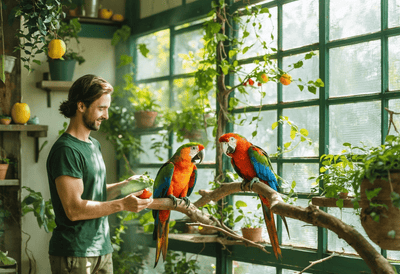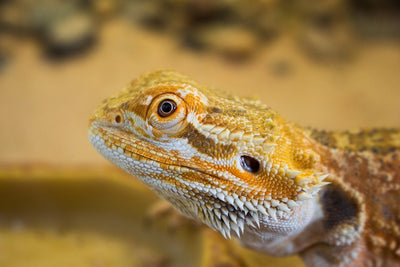Creating a Comfortable and Safe Environment for Iguanas

Providing a comfortable and safe environment for iguanas is crucial for their overall health and well-being. To ensure your pet thrives, it is important to consider various factors when setting up their enclosure. These factors include space requirements, temperature and humidity control, lighting, and habitat accessories.
Iguana Enclosure Size
Providing your iguana with an adequately sized enclosure is crucial for its overall health and well-being. It is essential to consider the space requirements for different stages of iguana growth, as well as the importance of a proper enclosure size and choosing the right type of habitat or cage for your iguana.
Space Requirements for Different Stages of Iguana Growth
As iguanas grow, their space requirements change. When setting up an iguana enclosure, it is essential to consider the different stages of growth:
- Baby iguanas: At this stage, a smaller enclosure is suitable, but it is crucial to plan for future growth. A baby iguana requires at least a 20-gallon enclosure, but upgrading to a larger habitat as they grow is necessary.
- Juvenile iguanas: As your iguana grows, so does its need for space. Juvenile iguanas need an enclosure that is at least 4 feet long, 2 feet wide, and 3 feet tall to ensure they have enough room to move and explore.
- Adult iguanas: Adult iguanas can grow up to 6 feet in length, and their enclosure should reflect their size. A suitable enclosure for an adult iguana should be at least 6 feet long, 4 feet wide, and 6 feet tall to provide ample space for them to move and exercise.
Importance of Proper Enclosure Size for Iguana's Health and Well-being
Ensuring your iguana has enough space to move and explore is critical for its overall health. Inadequate space can lead to stress, which can manifest in various health issues such as weakened immune systems, poor appetite, and lethargy. Additionally, a properly sized enclosure allows your iguana to engage in natural behaviors, such as climbing and basking, which are essential for their mental and physical well-being.
Choosing the Right Type of Habitat or Cage for Iguanas
When selecting an enclosure for your iguana, consider materials that are easy to clean and maintain, such as glass or PVC. The enclosure should have proper ventilation and offer a secure, escape-proof environment. It is also essential to ensure the cage has ample space for lighting, heating, and accessories such as climbing branches and hiding spots. By carefully choosing the right type of habitat or cage for your iguana, you can provide them with a comfortable and safe environment in which they can thrive.
Iguana Enclosure Setup
When setting up an iguana enclosure, it is important to create a comfortable and safe environment that meets the specific needs of your pet. This includes choosing the proper terrarium substrates, incorporating safe plants and branches, creating hiding spots and climbing structures, and ensuring proper ventilation and air circulation.
Proper Terrarium Substrates for Iguanas
Selecting the right substrate is crucial for maintaining the cleanliness and hygiene of your iguana's enclosure. Appropriate substrates for iguanas include cypress mulch, coconut coir, or reptile carpet. It is important to avoid using materials such as sand or gravel as they can cause impaction if ingested by your iguana.
Safe Plants and Branches to Include in the Enclosure
Incorporating live plants and branches not only adds natural beauty to the enclosure but also provides your iguana with additional hiding and climbing opportunities. Choose non-toxic plants such as hibiscus, pothos, or spider plants, and make sure to use sturdy branches that can support the weight of your iguana. Regularly inspect the plants and branches for signs of wear or damage and replace them as needed.
Creating Hiding Spots and Climbing Structures for Iguanas
Iguanas are arboreal creatures, which means they love to climb and explore. Providing hiding spots and climbing structures within the enclosure will help to stimulate their natural behaviors and encourage physical activity. You can use items such as PVC pipes, large cork bark tubes, or commercially available reptile hides to create secure hiding spots. Additionally, consider incorporating ramps, ledges, and hammocks to create a multi-level environment for your iguana to explore.
Ensuring Proper Ventilation and Air Circulation in the Enclosure
Good air circulation is vital for maintaining a healthy environment for your iguana. Ensure the enclosure has proper ventilation, such as mesh screens on the top and sides, to allow for air exchange. Regularly monitor the temperature and humidity levels within the enclosure to ensure they remain within the ideal range for your iguana. If necessary, make adjustments by using fans or adjusting the enclosure's heating and lighting systems.
Temperature and Humidity Control
Creating a comfortable environment for your iguana involves maintaining proper temperature and humidity levels within their enclosure. As ectothermic animals, iguanas rely on external heat sources to regulate their body temperature. Thus, it is essential to know the ideal temperature ranges for iguanas, and the importance of maintaining proper humidity levels.
Ideal Temperature Ranges for Iguanas
Iguanas thrive in temperatures ranging from 85 to 95°F (29 to 35°C) during the day and 75 to 80°F (24 to 27°C) at night. A basking area with temperatures of 90 to 95°F (32 to 35°C) should be provided so that the iguana can warm up as needed. It is crucial to create a temperature gradient within the enclosure, allowing your iguana to thermoregulate by moving to different areas of their habitat depending on their needs.
Maintaining Proper Humidity Levels
Humidity is another essential factor in keeping your iguana healthy and comfortable. The ideal humidity level for iguanas is around 65 to 75%. Low humidity can lead to dehydration and shedding problems, while excessive humidity may cause respiratory issues. Providing a shallow water dish and misting the enclosure regularly can help maintain proper humidity levels.
Temperature and Humidity Control Tools
Various tools and equipment can help regulate temperature and humidity levels in an iguana enclosure. Thermostats, thermometers, lights, hoods, fixtures, and heat sources, such as heat lamps or ceramic heat emitters, can be used to maintain the appropriate temperature. A hygrometer will measure humidity levels, ensuring they stay within the ideal range for your iguana's comfort and health.
Monitoring and Adjusting Temperature and Humidity
Regularly monitoring temperature and humidity levels is crucial to maintaining a comfortable environment for your iguana. Check the thermometer, thermostat, and hygrometer readings daily, making necessary adjustments to heat sources, lighting, or humidity as needed. By keeping a close eye on these factors, you can ensure your iguana has a safe and comfortable habitat to thrive in.
Lighting Requirements for Iguanas
Providing proper lighting, specifically ultraviolet (UV) light, is crucial for iguanas' health and well-being. UV light helps iguanas synthesize vitamin D3, which is essential for their calcium metabolism and overall bone health. Without adequate UV light exposure, iguanas can develop serious health issues, such as metabolic bone disease.
There are different types of UV lights available in the market that are suitable for iguana enclosures. These include fluorescent tubes, compact fluorescent bulbs, and mercury vapor bulbs. Each type has its own benefits and drawbacks. Fluorescent tubes, for example, are energy-efficient and can cover a larger area of the enclosure. However, they need to be replaced more frequently than mercury vapor bulbs. On the other hand, mercury vapor bulbs provide both heat and UV light, but they can be more expensive and have a higher risk of causing burns if not used correctly.
When setting up the lighting in your iguana's enclosure, it is important to consider the placement and duration of UV light exposure. The UV light source should be placed at an appropriate distance from the basking area, usually around 10-12 inches away, to ensure that your iguana receives the right amount of UV light without risking overheating or burns. Make sure to also provide a gradient of light and temperature within the enclosure, so your iguana can self-regulate its exposure to heat and UV light.
As for the duration of UV light exposure, iguanas typically require 10-12 hours of UV light per day to maintain their health. It is essential to establish a consistent day and night cycle for your iguana by turning off the UV light during the night. This will help them establish a routine and reduce stress, contributing to a comfortable and safe environment for your iguana.
Iguana Diet and Nutrition
Providing a well-balanced diet is crucial for maintaining the overall health and well-being of iguanas. A proper diet ensures that iguanas receive all the necessary nutrients, vitamins, and minerals they need to grow, thrive, and exhibit their natural behaviors. In this section, we will discuss the types of food suitable for iguanas and the appropriate feeding frequency and portion sizes to ensure a healthy and happy pet.
When it comes to the types of food suitable for iguanas, it's essential to remember that they are primarily herbivores. Their diet should consist mainly of dark, leafy greens, such as collard greens, mustard greens, and dandelion greens. Vegetables like bell peppers, carrots, and squash can also be included in their diet. Occasionally, small amounts of fruits, such as berries, apples, and bananas, can be offered as treats. It's crucial to avoid feeding iguanas animal-based proteins, as this can lead to severe health problems.
Feeding frequency and portion sizes for iguanas depend on their age and size. Baby and juvenile iguanas should be fed daily, while adult iguanas can be fed every other day. When determining the appropriate portion size, consider the size of the iguana's head. A good rule of thumb is to offer an amount of food that is roughly the same size as the iguana's head. This ensures that the iguana receives enough food without overfeeding. Always consult with a veterinarian for specific dietary recommendations tailored to your iguana's needs.
VII. Regular Maintenance and Cleaning
Keeping an iguana enclosure clean and hygienic is crucial for the health and well-being of your pet. A tidy environment helps prevent the growth of harmful bacteria and parasites, ensuring your iguana stays healthy and happy. In this section, we will discuss the importance of maintaining cleanliness in your iguana's enclosure and offer some tips for efficient cleaning and substrate replacement.
A. Importance of keeping the enclosure clean and hygienic
Maintaining a clean iguana enclosure is essential for several reasons. First, it reduces the risk of illnesses caused by bacteria, fungi, and parasites. Second, it helps eliminate unpleasant odors and maintain a visually appealing habitat. Finally, a clean environment encourages natural behaviors in iguanas, such as climbing, basking, and feeding, which are necessary for their overall well-being.
B. Tips for effective and efficient cleaning of the enclosure
To keep your iguana's enclosure clean and hygienic, follow these tips:
- Spot clean daily by removing any waste, uneaten food, and soiled substrates. This practice prevents the build-up of harmful microorganisms and keeps the enclosure smelling fresh.
- Use a reptile-safe disinfectant when cleaning the enclosure, ensuring it is non-toxic and appropriate for iguanas.
- Thoroughly clean and disinfect the enclosure, including the walls, floor, and furnishings, at least once a month. This deep cleaning helps eliminate any lingering bacteria, fungi, or parasites.
- Wash and disinfect any food and water dishes daily to prevent the growth of harmful microorganisms.
- Regularly check your iguana's enclosure for signs of mold, especially in areas with high humidity. If you find any mold, remove it immediately and take steps to prevent its recurrence.
C. Frequency of cleaning and replacing substrates
The frequency of cleaning and replacing substrates in your iguana's enclosure depends on the type of substrate used. For example, newspaper or paper towels should be replaced daily, while other substrates like coconut coir or cypress mulch may only need to be replaced every few weeks. Regardless of the substrate type, it is essential to spot clean the enclosure daily and perform a thorough cleaning at least once a month.
Conclusion
In conclusion, providing a comfortable and safe environment for your iguana is crucial to ensure its health and happiness. To recap the key factors to consider when setting up an iguana enclosure, remember to choose the right size habitat that accommodates your iguana's growth, use proper terrarium substrates, include safe plants and branches, create hiding spots and climbing structures, maintain proper ventilation, and control temperature and humidity levels. Additionally, provide appropriate lighting and ensure a well-balanced diet for your iguana.
By paying attention to these essential elements, you can create an ideal enclosure that significantly impacts the well-being of your pet iguana. A proper enclosure setup not only promotes the physical health of your iguana but also contributes to its mental well-being, allowing it to thrive and exhibit natural behaviors in captivity. Remember, a happy and healthy iguana makes for a more enjoyable and fulfilling pet ownership experience.
Discover Reptile Essentials
Now that you have a better understanding of how to create a comfortable and safe environment for your iguana, explore the range of reptile care products available on the Talis US website . Find terrarium substrates, habitats, cages, stands, and starter kits that cater to your iguana's specific needs.
Visit the general reptile products page to browse various reptile housing accessories, and use the search function to find iguana-specific items. Providing the right enclosure size and setup for your iguana will ensure their health and happiness for years to come.






